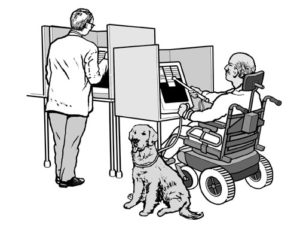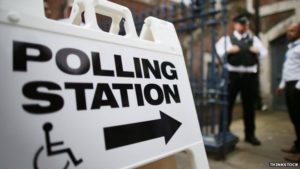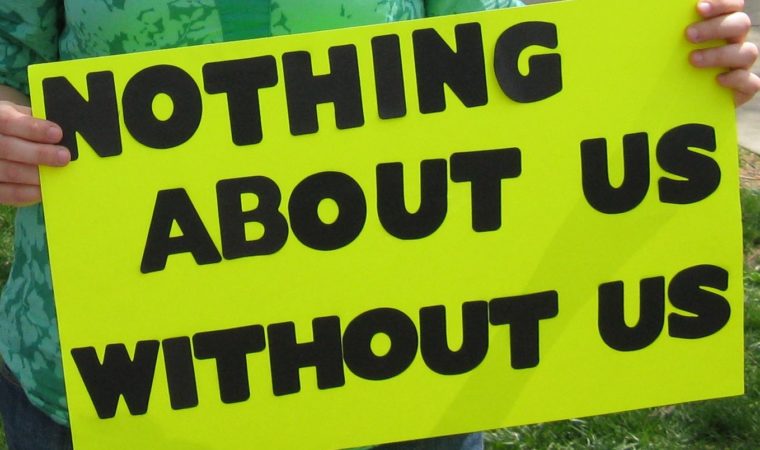Written by Carly Verbeke:
In the 2016 election, 35.4 million people with disabilities were eligible to vote – meaning that they represented one out of every seven potential voters that November. This couldn’t come as that much of a surprise, since the disabled population has consistently been the largest minority group in America. As such, one could expect the disabled population to have great representation at the polls during election time. However, even though the disabled population makes up the largest minority group in America, their actual voter turnout has consistently been less than that of people without disabilities. In 2016, 55.9% of eligible people with disabilities reported voting, compared to 62.2% of people without. That means that there was a gap of 6.3 percentage points. This gap was very similar in the general elections of 2008, where the gap was 7.2 points, and 2012, where it was 5.7 points.
Why is that? Several factors contribute to the gap, but the barriers in getting to or using polling places is one of the most significant. Living in an area with streets in poor condition is linked to substantially lower voter turnout among people with mobility limitations, and difficulty finding and getting to the polling place lowers voter turnout among people in general. Aside from being unable to get to the polling place itself, 30% of voters with disabilities reported some type of difficulty in voting – whether it be reading or seeing the ballot, or being able to mark the ballot itself.
With the disability community making up such a large percentage of the voting population, there has to be some sort of solution. Citizens with disabilities have reported benefitting from more flexible opportunities to vote in recent elections, including voting in-person before election day or by mail. Although these seem to be relatively easy and viable solutions, most polling places are reluctant to offer them. Even after laws such as the Help America Vote Act of 2002 (HAVA), which requires polling places to be accessible, the United States Government Accountability Office found that only 40% of polling places in 2016 had no potential impediments to access for people with disabilities. This is still not good enough. What else can be done?
According to the available research, the best way to increase accessibility and voting opportunities includes training election officials and poll workers to assist patrons with disabilities who request it, as well as the introduction of mobile voting. States have increasingly focused on developing and expanding training for poll workers and election officials, often in partnership with disability services and advocacy organizations. These efforts
have included videos on accessibility and poll worker assistance for voters with disabilities, conferences on polling place accessibility, and direct training for county election clerks and state election officials. Mobile voting, on the other hand, consists of bringing ballots or other voting equipment to convenient locations, such as long-term care facilities and shopping centers located on accessible bus routes. Mobile voting can help reduce concerns about voter fraud and enhance residents’ dignity and rights.
 In the disability community, there is a saying that goes “nothing about us without us,” because we want our voices to be included in the conversation, whether the issue at hand affects us directly or not. However, looking at the numbers that surround recent elections, it seems like there’s actually a lot being said and done for us. This isn’t because we don’t want to be included in the conversation; it is simply because the majority of us can’t get access to the polls. The United States Constitution guarantees everyone the right to vote, but does “everyone” really mean everyone if 1 in 7 voters can’t actually exercise that right? As the disability rights movement gains momentum, it is clear that we will not be silent much longer.
In the disability community, there is a saying that goes “nothing about us without us,” because we want our voices to be included in the conversation, whether the issue at hand affects us directly or not. However, looking at the numbers that surround recent elections, it seems like there’s actually a lot being said and done for us. This isn’t because we don’t want to be included in the conversation; it is simply because the majority of us can’t get access to the polls. The United States Constitution guarantees everyone the right to vote, but does “everyone” really mean everyone if 1 in 7 voters can’t actually exercise that right? As the disability rights movement gains momentum, it is clear that we will not be silent much longer.


 In the disability community, there is a saying that goes “nothing about us without us,” because we want our voices to be included in the conversation, whether the issue at hand affects us directly or not. However, looking at the numbers that surround recent elections, it seems like there’s actually a lot being said and done for us. This isn’t because we don’t want to be included in the conversation; it is simply because the majority of us can’t get access to the polls. The United States Constitution guarantees everyone the right to vote, but does “everyone” really mean everyone if 1 in 7 voters can’t actually exercise that right? As the disability rights movement gains momentum, it is clear that we will not be silent much longer.
In the disability community, there is a saying that goes “nothing about us without us,” because we want our voices to be included in the conversation, whether the issue at hand affects us directly or not. However, looking at the numbers that surround recent elections, it seems like there’s actually a lot being said and done for us. This isn’t because we don’t want to be included in the conversation; it is simply because the majority of us can’t get access to the polls. The United States Constitution guarantees everyone the right to vote, but does “everyone” really mean everyone if 1 in 7 voters can’t actually exercise that right? As the disability rights movement gains momentum, it is clear that we will not be silent much longer.